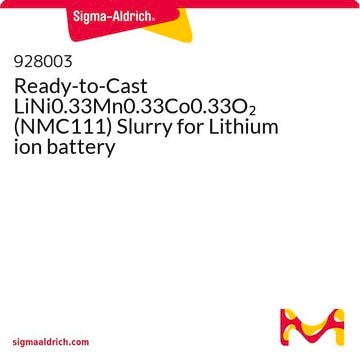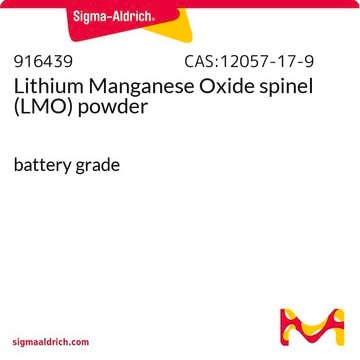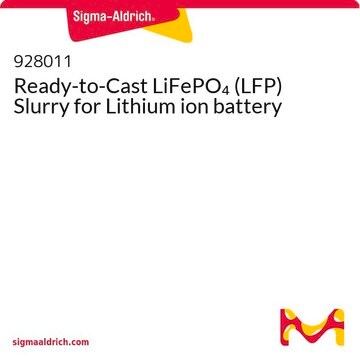765171
Lithium nickel cobalt aluminium oxide
electrode sheet, aluminum substrate, size 5 in. × 10 in.
Synonyme(s) :
NCA
About This Item
Produits recommandés
Qualité
battery grade
Description
Nominal Voltage: 3.7 V, Li/Li+
Pureté
≥98%
Composition
loading, ≥80%
Caractéristiques du produit alternatif plus écologique
Design for Energy Efficiency
Learn more about the Principles of Green Chemistry.
sustainability
Greener Alternative Product
Ampleur du marquage
≥80% loading
Taille
5 in. × 10 in.
Épaisseur
12-25 μm
Taille des particules
10-13 μm (typical)
Capacité
150 mAh/g(minimum)
180 mAh/g(nominal at 0.1C)
Pf
>1000 °C
Application(s)
battery manufacturing
Autre catégorie plus écologique
, Enabling
Description générale
Application
The NCA casted electrode sheets can be cut into appropriate size and is ready to be used in lithium ion batteries.
Autres remarques
Operating Condiditons:
- Recommended maximum charge voltage: 4.3 V vs Li/Li+
- Recommended maximum charge current: 4C
- Recommended cut-off voltage for discharge: 3.0 V vs Li/Li+
- Recommended charge method: constant current - constant voltage
Mention d'avertissement
Warning
Mentions de danger
Conseils de prudence
Classification des risques
Carc. 2 - Skin Sens. 1
Code de la classe de stockage
11 - Combustible Solids
Classe de danger pour l'eau (WGK)
WGK 3
Point d'éclair (°F)
Not applicable
Point d'éclair (°C)
Not applicable
Certificats d'analyse (COA)
Recherchez un Certificats d'analyse (COA) en saisissant le numéro de lot du produit. Les numéros de lot figurent sur l'étiquette du produit après les mots "Lot" ou "Batch".
Déjà en possession de ce produit ?
Retrouvez la documentation relative aux produits que vous avez récemment achetés dans la Bibliothèque de documents.
Les clients ont également consulté
Articles
Professor Qiao's review explores stable microstructures for lithium metal fluoride batteries, advancing energy storage technologies.
Solid oxide fuel cells and electrolyzers show potential for chemical-to-electrical energy conversion, despite early development stages.
Li-ion batteries are currently the focus of numerous research efforts with applications designed to reduce carbon-based emissions and improve energy storage capabilities.
Lithium-ion batteries offer high energy density and cyclic performance for portable electronic devices.
Notre équipe de scientifiques dispose d'une expérience dans tous les secteurs de la recherche, notamment en sciences de la vie, science des matériaux, synthèse chimique, chromatographie, analyse et dans de nombreux autres domaines..
Contacter notre Service technique















